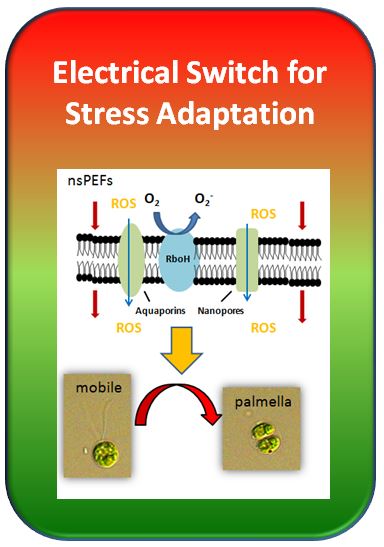2017_01 Nanosecond current switches microalgae
What was the motivation?
Stress is part of life - no living being is always in equilibrium. A finely tuned and swift regulatory network has to reestablish balance again and again. However, there are situations where survival is at stake, when cellular integrity is perturbed to a degree, where the cell fails to re-establish homeostasis. The interface of a cell, its membrane, is the location, where integrity is most vulnerable. In the past, we worked out that a very dynamic component of the actin cytoskeleton can sense disruptions of membrane integrity through measuring the level of reactive oxygen species (Chang and Nick 2015, Eggenberger et al. 2017). In response to such disruptions, growth is arrested, and a stress response is launched. Likewise, the cell cycle is arrested which activates cell differentiation, or, in some cases, culminates in programmed cell death. If this working model is correct, even mild perturbations of membrane integrity should be able to evoke such adaptive stress responses.
Idea: Nanosecond-electrical pulses as trigger
Since more than a decade, we have been collaborating with the team of Dr. Wolfgang Frey at the Institute for Pulsed Power and Microwave Technology (IHM) at the KIT-Campus North. Our topic is the effect of ultra-short (nano-seconds), but ultra-strong (kilo-Volt per cm) electrical pulses on plant cells. Our previous work demonstrated that such nsPEFs (for nanosecond Pulsed Electrical Fields) make actin detach rapidly from the membrane, what shifts the cell into programmed cell death (the plant version of apoptosis). Our idea was now to elicit by nsPEFs a specific stress response. Target were unicellular microalgae, because here, in frame of a project funded by the Foundation of the State of Baden-Württemberg, biotechnological applications were analysed. Moreover, these algae can be conveniently pulsed using a pulsing chamber.
What were the results?
First, the energies had to be calibrated such that the algae (we used the unicellular Green Algal model Chlamydomonas reinhardtii) would be stimulated, but not damaged. Based on our long-standing experience with other cells, the parameters were already known. The pulses caused small membrane pores, but these became resealed within a few minutes. In parallel, the cells were swelling somewhat, but within one hour they returned to their original size and appeared to have completely coped with the consequences of pulse. However, we observed a strong increase in lipid peroxidation, indicative of reactive oxygen species (ROS). But even this "oxidative burst" faded after some hours. We first reasoned that the pulse would not leave any persistent trace. This was wrong! A few days later, the treated cells stopped to divide, increased in size and developed a second, massive oxidative burst. Eventually, they shed their flagella and formed a solid sheath. This palmella stage helps to survive under conditions of drought and, thus, represents an adaptation response. The electric treatment released a signal that persisted over several days and then activates a developmental response. We reckoned that this signal is generated actively as response to perturbation of membrane integrity. A membrane bound enzyme, NADPH oxidase, might act as sensor. This enzyme converts oxygen into superoxide at the outer face of the membrane. Superoxide permeates through the membrane only poorly. However, when membrane integrity is disrupted, even transiently, superoxide will enter the cell and cause lipid peroxidation, which might form the (unknown) palmella signal. If this hypothesis were correct, inhibition of NADPH oxidase should also block the longterm responses to nsPEFs. Using low (2 µM) concentrations of the inhibitor dephenylene iodonium chloride (DPI), we were able to confirm this prediction experimentally.
What does this mean?
Already unicellular Green Algae seem to harbour a sensor for cell integrity that works by measuring the passage of superoxide through the membrane, leading to adaptive cell responses. We had already found the same mechanism in cells of tobacco and grapevine (Chang and Nick 2015, Eggenberger et al. 2017). Using nsPEFs, it is possible to modulate signalling in a specific manner. What does this mean for biotechnological application? If one understands biology, it is possible to manipulate organisms in a targeted way without the need for extensive energy input.
publication
130. Bai F, Gusbeth C, Frey W, Nick P (2017) Nanosecond pulsed electric fields trigger cell differentiation in Chlamydomonas reinhardtii. BBA Membranes 1859, 651-661 - pdf

